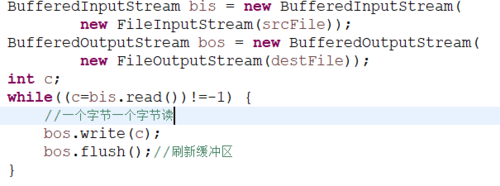关于BufferedOutStream 到底怎么写文件的

视频中不是说
FileOutputStream-->write()方法相当于一滴一滴地把水"转移"过去
DataOutputStream-->wtireXxx()方相当于一瓢一瓢把水"转移"过去
BufferedOutputStream-->write方法相当于一瓢一瓢先放入桶中,在从桶中倒入到另一个缸中,性能提高
那按照while中的代码,怎么还是感觉是一个字节一个字节读的,没有体现出瓢和桶的概念啊?不懂

视频中不是说
FileOutputStream-->write()方法相当于一滴一滴地把水"转移"过去
DataOutputStream-->wtireXxx()方相当于一瓢一瓢把水"转移"过去
BufferedOutputStream-->write方法相当于一瓢一瓢先放入桶中,在从桶中倒入到另一个缸中,性能提高
那按照while中的代码,怎么还是感觉是一个字节一个字节读的,没有体现出瓢和桶的概念啊?不懂
2018-09-24
FileOutputStream的write(int)是直接把字节写到磁盘文件上,相当于直接从这个山头的缸中取了一滴水,然后爬到另一个山头放入那个缸中。
FileOutputStream的write(byte[])是直接把字节先写到字节数组中,然后统一写到磁盘文件上,相当于直接从这个山头的缸中舀一瓢水,然后爬到另一个山头倒入那个缸中。
DataOutputStream的writeXxx()理解跟FileOutputStream的write(byte[])差不多
BufferedOutputStream的write(int)方法相当于把字节一个一个放入一个缓冲区中,再一次性将缓冲区中的内容写到磁盘文件上。相当于将这个山头的水缸中的水一滴一滴放入铁桶中,当这个水缸的水放完了,你再抱着这个铁桶一次性的将水倒入另一个山头的缸中。
BufferedOutputStream的write(byte[])方法是最牛逼的,把字节一部分一部分的拿出,每次拿出都放入字节数组,再将字节数组放入缓冲区中,再一次性将缓冲区中的内容写到磁盘文件上。相当于从这个山头的水缸中一瓢一瓢的舀水放入铁桶中,当这个水缸舀完了,你再抱着这个铁桶一次性的将水倒入另一个山头的缸中。
你说哪个方法走的路少比较轻松? 下面是我的代码,DataOutputStream的没有写。你比较下
package com.imooc.io;
import java.io.*;
public class IOUtil {
public static void copyFileByByte(File sourceFile,File destinationFile) throws IOException{
if( !sourceFile.exists() ) {
throw new IllegalArgumentException(sourceFile+"文件不存在");
}
if( !sourceFile.isFile() ) {
throw new IllegalArgumentException(sourceFile+"不是文件");
}
FileInputStream fis=new FileInputStream(sourceFile);
FileOutputStream fos=new FileOutputStream(destinationFile);
int b;
while( (b=fis.read())!=-1 ) {
fos.write(b);
fos.flush(); //最好加上
}
fis.close();
fos.close();
}
public static void copyFileByByteArray(File sourceFile,File destinationFile) throws IOException{
if( !sourceFile.exists() ) {
throw new IllegalArgumentException(sourceFile+"文件不存在");
}
if( !sourceFile.isFile() ) {
throw new IllegalArgumentException(sourceFile+"不是文件");
}
FileInputStream fis=new FileInputStream(sourceFile);
FileOutputStream fos=new FileOutputStream(destinationFile);
byte[] buf=new byte[16*1024];
int b;
while( (b=fis.read(buf,0,buf.length))!=-1 ) {
fos.write(buf,0,b);
fos.flush(); //最好加上
}
fis.close();
fos.close();
}
public static void copyFileByBufferByByte(File sourceFile,File destinationFile) throws IOException{
if( !sourceFile.exists() ) {
throw new IllegalArgumentException(sourceFile+"文件不存在");
}
if( !sourceFile.isFile() ) {
throw new IllegalArgumentException(sourceFile+"不是文件");
}
BufferedInputStream bis=new BufferedInputStream( new FileInputStream(sourceFile) );
BufferedOutputStream bos=new BufferedOutputStream( new FileOutputStream(destinationFile) );
int b=0;
while( (b=bis.read())!=-1 ) {
bos.write(b);
}
bos.flush();
bis.close();
bos.close();
}
public static void copyFileByBufferByByteArray(File sourceFile,File destinationFile) throws IOException{
if( !sourceFile.exists() ) {
throw new IllegalArgumentException(sourceFile+"文件不存在");
}
if( !sourceFile.isFile() ) {
throw new IllegalArgumentException(sourceFile+"不是文件");
}
BufferedInputStream bis=new BufferedInputStream( new FileInputStream(sourceFile) );
BufferedOutputStream bos=new BufferedOutputStream( new FileOutputStream(destinationFile) );
byte[] buf=new byte[16*1024];
int b=0;
while( (b=bis.read(buf,0,buf.length))!=-1 ) {
bos.write(buf,0,buf.length);
}
bos.flush();
bis.close();
bos.close();
}
}
举报